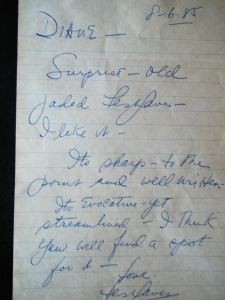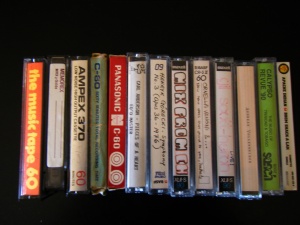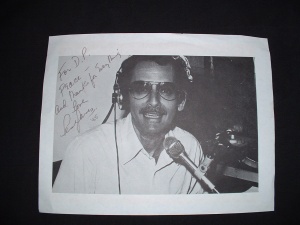In early December, a holiday card from the Santana Organization arrived in my mailbox—just as it has every December for the past few decades. And it always makes me smile at my connections with the Santana family.
Back in 1980 when WRVR went off the air, I was crushed. That radio station had introduced me to jazz and “fusion” music, and now I would no longer be able to get my fill of my new favorite music and musicians. But by the mid-80s, it was positively exasperating how many of my favorite artists were missing from the radio! So being young and idealistic, I hatched a plan: I would find some of those artists, interview them, and write a book about them, thereby giving them their propers.
Now remember, this was before the Internet, so the only way to find people was through physical, archival, old school research: telephone books, library reference departments, physical newspapers, physical magazines, phone calls. But if you know me, you know that I was BORN researching! So it was no problem for me to begin tracking down these artists. And high on my list was the Santana band.

A shelf’s eye view of some of my Santana albums. Not shown: the Santana CDs in my collection! (click on photo to enlarge)
By then I’d been a music journalist for awhile, and I had lots of contacts in record companies and entertainment publications. So I finally reached the Santana Organization and spoke with a very nice woman named Kitsaun King, who sent me press information about the group, and put me on their mailing list.
In 1987, I took my second trip to London. Before leaving, I looked up interesting events that might be happening during my time there. (Again I remind you, dear reader, that this pre-dates the Internet.) Luckily, I worked in the building that housed the British Tourist Authority, and in their offices were copies of TIME OUT magazine. Which is how I discovered that there was a Santana concert at Hammersmith Odeon on one of the nights I’d be there! Without hesitation, I contacted Kitsaun to ask if I could come and meet her and the band, and she said YES!
Meeting the Parents
I remember going to the Hammersmith Odeon stage door and being met by Kitsaun, who escorted me to the band area. It was a huge room filled with people, including an older couple that Kitsaun introduced to me as Santana’s parents.
This was especially exciting to me. You see, on Santana’s 1983 album Havana Moon, there was a tune that I loved called Vereda Tropical. In the liner notes, Carlos Santana wrote that as a child, he’d heard the song being sung by his father, who was a mariachi singer, to his mother after they’d had a lovers’ quarrel, and that she’d cried when she heard it on the album. So after our introduction, I began to tell Mr. and Mrs. Santana how much I enjoyed that song and the story behind it. One sentence in, though, Mr. Santana expressed to me that they couldn’t speak English very well!
Silently I thought, awww HELL naw—I’m not gonna blow this opportunity to speak with the PARENTS of my idol! So I reached back into my brain and pulled out my Spanish, and you better believe we had a conversation! I told them that it was a special pleasure to meet them, since I’d been moved by that song. I asked Mr. Santana about his experience as a mariachi singer, and Mrs. Santana about her experience being the mother of a famous musician. While I didn’t record or even write down our conversation, it was one of those experiences that… well, you know. A beautiful memory.
Mr. Santana told me to keep in touch, and wrote their address and phone number for me on a card. Although I never called them, I still have the card.
Soon, it was time for the band to go onstage, and I had the happy experience of watching the show from backstage. That’s probably why to this day, during a concert I prefer to sit or stand in odd places (offstage, backstage, roaming around) to sitting in the audience!
But Wait: There’s More
After that, every year I would exchange holiday greetings with Kitsaun and the Santana organization. Years later, I was thrilled (vindicated?) when the band became a household name again. Once, when they were in New York, I met up with Kitsaun in their hotel room. As we were talking, Santana and his son Salvador—then just a young boy of maybe ten?—showed up, and we just sat around chatting. What? Me, DP, in a hotel room with Carlos and Salvador Santana??
But the whole thing came full circle when in 2005, I learned that Deborah Santana, Carlos’s wife, had written a memoir called Space Between the Stars. The book moved me deeply because it was the most candid memoir I’d ever read—and I am a memoir JUNKIE. To this day it remains the example of memoir writing that I refer aspiring authors to. And through reading it, I realized that Deborah was Kitsaun’s sister!! How odd was it that I had never met Deborah or even known that she was Carlos’s wife, let alone that she and Kitsaun were sisters? So after reading it, I reviewed the audiobook, then reached out and interviewed her for Publishers Weekly , and it was a true pleasure to connect with such an honest and creative woman.
That year, Deborah was scheduled to attend the annual bookseller’s convention in New York, and I was looking forward to meeting her for the first time. The second day, as I was cruising the packed convention floor, I heard someone call my name. I turned around, and there was Kitsaun, whom I hadn’t seen in years, and Deborah! I was amazed that Kitsaun recognized me after all that time. So we all had a very nice reunion. And just a couple of years ago, I found out that Deborah was back in NYC to host a book signing for a friend of hers, so I surprised her by showing up for a hug.
As I’ve said, Deborah’s book was very candid about her relationship with Carlos; part of it described his womanizing and her reaction to it. At the end, I was surprised that she stayed with him, but in the book she explained that choice. Imagine my further surprise when several years later, I read somewhere that they had divorced. Part of me thought, wow, getting those feelings and memories out must have been more cathartic for Deborah than she realized! And every chance I get, I recommend the book to anyone who is writing a memoir. Oh, and during the writing process, Deborah was part of an excellent writers group. I recommend that too!















